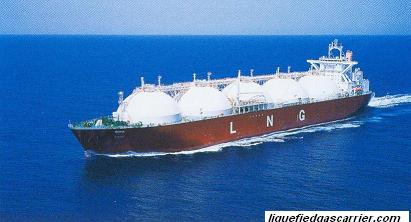

Home page|||
LNG handling |||
LPG handling||| Other Gas products|||
Fire & Safety|||
Emergency response |||
Sea transport of bulk natural liquefied gases - LNG & LPG carriers Safety & operational matters
Carrying liquefied gases in bulk
A liquefied gas is the liquid form of a substance which, at ambient temperature and at atmospheric pressure, would be a gas.The same liquefied gas at the same temperature, in a closed
container, will always have the same pressure. Therefore, butane at
the same temperature has an identical pressure irrespective of
whether the container is the tank of a gas carrier, a simple gas
cigarette lighter, a storage tank, or a domestic gas bottle All are
pressurised containers.

Most liquefied gases are hydrocarbons and the key property that makes hydrocarbons the world’s primary energy source – combustibility – also makes them inherently hazardous. Because these gases are handled in large quantities, it is imperative that all practical steps are taken to minimize leakage and to limit all sources of ignition.
Gases are always liquefied for transportation in bulk simply because
more cargo can be fitted in a given volume. Typically, but dependent
upon the product, 1 volume of liquefied petroleum gas (LPG) is
equivalent to over 250 volumes of vapour and 1 volume of liquefied
natural gas (LNG) equivalent to 600 volumes of vapour.
Carrying and handling liquefied gas cargo onboard poses significant potential hazards including risk of injury or death,threats to environment and each person working on a gas carrier and terminal ashore needs to understand the risks involved, obtain the necessary training and take all the needed precautions.
LNG used as fuel for ships gas engines is the best choice as
far as the emissions of CO2, SOx and NOx are concerned.
When considering the life-time cost for a gas engine , LNG is also the best fuel.
Our site is based on trans-ocean transport of liquefied gases in bulk , various gas carrier operation, onboard safety procedure, safe cargo loading , unloading , care at sea passage & other industry relevant safe practices .
The Principal Products -
Whilst the hydrocarbon gases methane, ethane, propane and butane may be regarded principally as fuels, the LPGs are also important as feedstock in the production of the chemical gases.
All gas cargoes are transported in liquid form (ie they
are not carried as a gas in its vapour form) and, because
of their physical and chemical properties, they are
carried either at:
pressures greater than atmospheric, or at
temperatures below ambient, or a combination
of both.
Therefore, gas carriers are generally grouped as follows:
i) Fully Pressurised
ii) Semi-pressurised and Refrigerated
iii) Fully Refrigerated
Gas carriers are divided into two main groups:
Liquefied Petroleum Gas (LPG) Carriers, which are
designed to carry mainly butane, propane, butadiene,
propylene, vinyl chloride monomer (VCM) and are able
to carry anhydrous ammonia.
Liquefied Natural Gas (LNG) Carriers, which are
designed to carry liquefied natural gas (which is mostly
methane).
On the basis of Tank Types used gas carriers may be classified as below:
Type ‘A’: Constructed of plain surfaces (prismatic tanks)
Type ‘B’: Spheres
Type ‘C’: Cylindrical pressure vessels
(Note. These tanks are used where appropriate,
regardless of gas carrier type)
Related Information:
- Various LNG carrier types
- Gas cargo containment systems - primary barrier (the cargo tank),secondary barrier, thermal insulation and more
- Principle gas products & their characteristics
- New concept for transporting stranded and remote gas
by compressed gas liquid carriers (CGLC)
- The double hull feature & general arrangement for Liquefied Gas Carriers
- The sea transport of liquefied gases in bulk -Where do the products come from ?
-
Training requirements LNG carriers
Reference publications
- Liquefied Gas Handling Principles on Ships and in Terminals
- International Safety Guide for Oil Tankers and Terminals
- International Code for the Construction and Equipment of Ships carrying Liquefied Gases in
Bulk 1993
- Code for the existing ships carrying Liquefied Gases in Bulk 1976 with Amendments and
Supplements.
- Code of Safe Working Practices
- International Convention for the Safety of Life at Sea 1974 & amendments
- International Convention on Standards of Training, Certification and Watch keeping for
Seafarers.
- SIGTTO Liquefied Gas Handling Principles On Ships And In Terminals
- Shipboard Oil Pollution Emergency Plan
- USCG Non-Tank Vessel Response Plan

// Home page///
LNG handling ///
LPG handling///
Sea transport ///
Gas products///
Cargo work
///Fire precautions
///Health hazards
///Safety Precautions
///Emergency response ///

Copyright © Liquefied Gas Carrier.com All rights reserved.
The content published in this website are for general reference only. We have endeavoured to make the information
as accurate as possible but cannot take responsibility for any errors. For latest information please visit www.imo.org .
Any suggestions, please Contact us !
///Links &Resources //
Terms of use///
Privacy policy///Home page///
